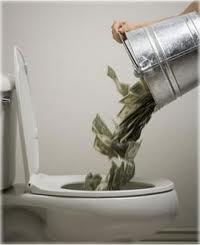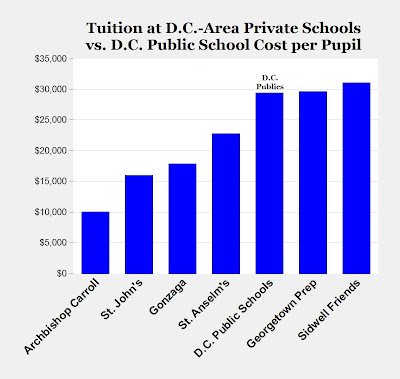WTH? Highest spending creates worst schools?
The $29,409 per-pupil cost for “free” public education in D.C. is a perfect example, and the future trend seems clear: spending on public schools will continue to increase and the academic results will continue to decline.

Higher school spending FAILs to improve education
By Mark J. Perry at Carpe Diem

Judging by the expenditures per student of almost $30,000 (Andrew Coulson at Cato crunches the numbers), the “pricy” District of Columbia public schools are among the most elite of all of the D.C.-area schools, see the chart above. The $29,409 per-student educational price tag for D.C. schools is just slightly below two of the area’s most prestigious private schools – Georgetown Prep ($29,625), founded in 1789 as the nation’s oldest Jesuit school, and Sidwell Friends School ($33,000), the “school of choice” for President Obama’s daughters. It’s also almost twice as expensive as Bethesda-based St. John’s College High School ($15,950) and almost three times as expensive as D.C.’s Archbishop Carroll ($10,500).
However, judging by the graduation rate of D.C.’s public high schools of only 58.6% for the Class of 2011 (compared to the national average of 75.5% for public schools), District taxpayers might wonder why they’re getting such poor results from such an elite level of spending. For every 100 students who graduated from D.C. high schools in 2011, there were 71 of their freshman classmates who either dropped out or didn’t graduate on time. At one of D.C.’s worst-performing high schools – Cardozo Senior High – fewer than 40% of its students graduated in 2011, which means that for every 100 students who graduated, there were 154 of their freshman classmates who did not graduate.
It wouldn’t be so troubling that the cost to educate students in D.C. school is comparable to the tuition of some of the most elite, D.C.-area private-schools, and 2-3 times the tuition of some of the area’s private Catholic high schools, if the graduation rates at D.C. public schools weren’t so miserably low. But when public school spending is so high in the District of Columbia (more than total state spending in both North Dakota and South Dakota), and the results are so miserable, you would think there would be more political support for alternative approaches like the “D.C. Opportunity Scholarship Program,” which President Obama and many Democrats oppose. Obama tried to kill the program by de-funding it, but the program was rescued by Republicans John Boehner and Joe Lieberman. Unfortunately, the president and Democrats are “more interested in doing right by teachers unions than doing right by ghetto kids confined to failing schools,” as Jason Riley pointed out in the WSJ.
Bottom Line: Russ Roberts reminds us that the most costly goods and services are often the ones that politicians decide should be “free,” like education, health care and housing. The $29,409 per-pupil cost for “free” public education in D.C. is a perfect example, and the future trend seems clear: spending on public schools will continue to increase and the academic results will continue to decline.
Dr. Mark J. Perry is a professor of economics and finance in the School of Management at the Flint campus of the University of Michigan. Perry holds two graduate degrees in economics (M.A. and Ph.D.) from George Mason University near Washington, D.C. In addition, he holds an MBA degree in finance from the Curtis L. Carlson School of Management at the University of Minnesota. He blogs at Carpe Diem.
Help Make A Difference By Sharing These Articles On Facebook, Twitter And Elsewhere:
